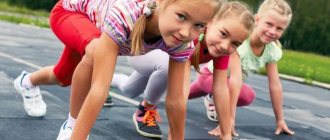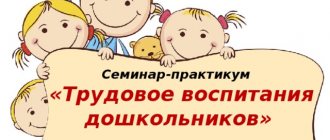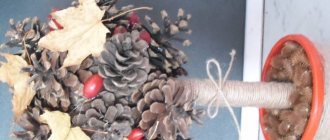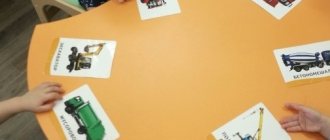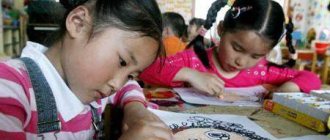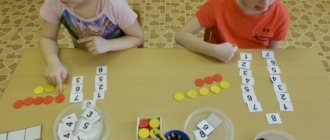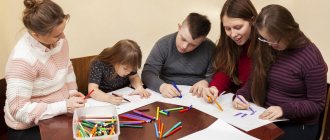Preview:
Self-analysis of GCD for drawing using non-traditional techniques “Winter Landscape”
Topic: “Winter landscape”
The lesson was conducted with children from the preparatory group; there were (7) children present. Children easily make contact with adults. They know how to hear and listen to the teacher.
When developing this lesson summary, I first of all took into account the age and mental individual characteristics of the children in the preparatory group.
Purpose of the lesson: to evoke aesthetic feelings towards nature and its images using an unconventional drawing technique.
During the lesson it was expected to solve the following problems
In accordance with the requirements of the Federal State Educational Standard, she used the following types of activities: gaming, cognitive, productive, motor.
-methods of consciousness formation (individual and frontal conversation);
-methods of organizing activities and developing behavioral experience (games, speech situations);
-methods of stimulating behavior (encouragement);
-methods of control, self-control and self-assessment (survey, analysis of the results of one’s own activities);
-methods of organizing and implementing cognitive activity (story, modeling a picture);
-methods of saving, preserving and strengthening health (games “Bring the Picture to Life”, finger play “Snowball”)
To successfully solve the identified problems, I have prepared the following:
Preparatory work: conversation about winter; viewing and talking about landscape paintings; drawing “Autumn landscape”; the use of modeling in direct educational activities.
Equipment and materials: models, tinted sheets of cardboard (for each child), stacks, skewers, ready-made dough for drawing; rags, Velcro pictures depicting objects and natural phenomena, plastic cups, audio recording of P.I. Tchaikovsky “Seasons. February” exhibition of paintings, presentation of paintings by famous artists.
The end result for the child: knows how to depict a winter landscape using an unconventional drawing technique, plans his activities and implements a preliminary plan, freely navigates a limited surface.
I think that drawing with non-traditional techniques aroused interest and activity among children.
The lesson consisted of three parts.
Contributed to the creation of psychological comfort. We set the children up for active work, positive contact with each other, provided psycho-emotional release, and created interest in the upcoming activity.
Aimed at creating a positive emotional mood and developing the educational situation itself. This part of the educational activity used a combination of game motivation, visual, verbal and practical methods.
1. To describe natural phenomena in winter, I used the didactic exercise “Winter - good, bad...”, as a result of which the children’s vocabulary is enriched with adjectives characterizing natural phenomena.
2. I solved the problem of developing visual perception, memory and logical thinking and cognitive activity in the process of viewing landscape paintings and working with model pictures related to the landscape.
3. Emotional expressiveness and the ability to convey the mood of a picture were reflected in the theatrical sketch-improvisation “A Picture Alive”. The children's ability to correlate words with movements and the expressiveness of performing movements was strengthened.
Determining the purpose of the topic (drawing a landscape)
Independent productive activity.
3. Final part.
Assessment of children's performance and self-esteem. Summing up the results of the GCD.
All stages of the lesson were interconnected and interdependent, subordinated to the given topic and goals of the lesson. Changing the type of activity at each stage of the lesson helped prevent fatigue.
I don’t forget that play is the leading activity for preschool children, so I offered the children the games “Winter – good, bad...”, “Picture Alive”.
During the lesson, to ensure the efficiency of the children's team, I used the following forms of organizing children's activities:
Team work with model pictures.
Throughout the entire lesson, I paid attention to the children’s speech: I sought complete answers, posed searching questions about how we could draw, and created conditions for dialogue with the children.
During the lesson, the children were active - they participated in the game and answered questions.
The children's interest remained throughout the lesson. The children were attentive.
Summing up the lesson, I involved the children in this and asked them to speak on the topic of what we know about painting and what other ways can we draw pictures.
CONCLUSIONS: – The stated topic was fully consistent with the content of the lesson.
— I believe that I managed to fully implement the assigned tasks.
Source
Preview:
on the topic: “Rowan Sprig” (“Artistic Creativity”)
in the middle preschool group from 4 to 5 years old
teacher of the MBDOU child development center of kindergarten No. 25 “Rodnichok”
Knyazeva Anna Vladimirovna
Integrated direct educational activities were carried out in a group of middle preschool age from 4 to 5 years. There were 10 people present.
The level of development of children is sufficient, relationships are favorable, children are friendly.
This activity belongs to the “Artistic Creativity” section of the program.
Integration of educational areas: “Cognition”; "Communication"; "Health"; “Reading fiction”; "Socialization".
Goal: to teach children to use various types of non-traditional drawing techniques, to practice drawing over the entire surface of the sheet.
Based on the goal of the GCD, I set the following tasks:
Educational field “Artistic creativity” Drawing Educational:
- teach children to draw in an unconventional way - print with leaves,
- strengthen the ability to draw with a cotton swab;
-develop the ability to paint with a brush on leaves, carefully hold them, turn them over and print with them.
- develop the ability to arrange an image throughout the sheet;
— promote the development of creative imagination, artistic and aesthetic skills, fine motor skills, attention;
- awaken aesthetic feelings, cultivate interest in the artistic word;
— to cultivate goodwill and a culture of communication between children and peers and adults.
Objectives of integrated educational areas.
Educational area "Cognition"
-clarify ideas about the rowan tree, expand ideas about the world around us.
Educational field "Communication"
— continue to teach children to give complete answers to the teacher’s questions, to develop monologue and dialogic speech.
Educational field "Health"
— maintain and strengthen the mental and physical health of children, form correct posture.
Educational field "Reading fiction"
- introduce children to verbal art.
Educational field "Socialization"
— to cultivate a culture of communication, goodwill, mutual understanding, love and respect for nature.
The duration and structure of the educational activity itself was consistent, using alternation of different types of activities. I implemented a health-saving approach to organizing educational activities:
— sanitary requirements for carrying out GCD complied with SanPiN standards. In the group, before the NOD, wet cleaning and ventilation were carried out. During the ECD, safety precautions were observed; children did not occupy a static position and were constantly in motion. The duration of the activity was according to the given age group (20 minutes).
The group room in which this educational activity was carried out was divided into separate zones, which made it possible to concentrate the children’s attention on performing certain tasks and to achieve discipline.
GCD corresponded to the interests, temperament, and level of preparedness of the children. The organization of children's activities is adequate to teaching, developmental and educational tasks. The formation of children’s knowledge throughout the activity was facilitated by the logical presentation of the material, accessibility, and the creation of a game situation. The transition from one type of activity to another made it possible to involve each child in an active process.
To implement the assigned tasks, I used various principles: (visuality, systematicity, accessibility, consistency, individual approach, development, voice and emotional modulation, psychological comfort).
- verbal (speech sample, explanation, repetition, clarification, clarification, request);
- visual (showing illustrative material, algorithm for performing work);
-practical (non-traditional drawing, printing, drawing with a cotton swab);
- game (surprise moment).
Thus, the goal and objectives set within the framework of the NOD were realized. Educational activities contributed to increasing playful motivation for learning, creative development, and cognitive interest. The topic of an entertaining case was considered from several sides: theoretical, practical and visual. The level of activity of children was at a sufficient level, all children were involved in activities, interest was maintained throughout the entire educational activity. This was facilitated by the use of various methods and techniques, a democratic style of communication with children, and the creation of a positive emotional background. All types of tasks planned with the children were carried out.
Source
Self-analysis of ECD for drawing in the senior group “Forget-me-not Gzhel”
Anna Efremova
Self-analysis of ECD for drawing in the senior group “Forget-me-not Gzhel”
Efremova Anna Borisovna
Self-analysis of GCD in the senior group (Drawing - Forget-me-not Gzhel)
Direct educational activities were carried out with students in the sixth year of life from a general developmental group of 18 people.
NOD "Forget-me-not Gzhel"
Goal: Continue to develop knowledge about Gzhel painting. Exercise children in creating Gzhel patterns and compositions.
Objectives: Practice creating Gzhel patterns and compositions. Exercise children in gouache painting. Continue to learn how to use several brushes of different thicknesses in painting. Development of drawing skills with the tip of the brush and the entire bristle. Strengthen dipping skills.
Educational areas: “Artistic and aesthetic development”, “Cognitive development”, “Speech development”, “Social and communicative development”.
Glossary: going well (work, tureen, decoration.
Preliminary work: Conversations: “Gzhel”, “Fairytale Gzhel and its origin”, “Gzhel masters”; Consideration of the album “Gzhel Painting” (examination of painting elements and compositions, GSD “Introduction to Gzhel Painting”, GZhel Patterns GCD, GZEL “Spreading Tree” GCD (on the subject of Gzhel painting, individual work on developing painting elements; glossary: products, craftsmen, candlestick, pattern, etc.; D. and.: “Fold the pattern”, “Choose a sweet word”, learning the poem “Gzhel”, getting acquainted and learning with physical education - minutes “Hello brothers”.
Methods and techniques:
Verbal:
Literary word explanation, clarification, advice, teacher's story, physical education - just a minute.
Visual:
exhibition of Gzhel products, decoration of the group.
Gaming:
game moment “Magic words” (transformation into masters).
Practical:
progress of work, drawing elements of a pattern in the air, physical education - a minute, listening to a song, musical accompaniment of work.
Materials and equipment: Oilcloth, gouache (white and blue, brush stand, 2 brushes, thin and thicker (No. 3, No. 5), water jar, palettes, paper napkins, various cut-out utensils or other items for decoration (vase, tureen, jug, plate, towel, handkerchief, etc., Gzhel products for the exhibition, tape recorder, recording of the song (Forget-me-not Gzhel" - Author: Yuri Mikhailovich Chichkov, performer: Nadezhda Filatova)
Duration 25-30 minutes (including viewing the exhibition).
The conditions for carrying out the GCD met SanPin standards: a clean room, fresh air, good lighting, furniture appropriate for the height of the children, and safety rules were followed. Preliminary work has been carried out.
The content of the tasks is structured taking into account the principle of integration of educational areas: artistic-aesthetic, cognitive, speech, social-communicative and physical development within the framework of the implementation of the Federal State Educational Standard. To implement the assigned tasks, all groups of methods and techniques were used: visual, verbal, practical, game.
The lesson was a success. In advance, the group was decorated with balloons (blue, white and light blue) with bouquets of forget-me-nots. An exhibition of Gzhel products was prepared. The lesson began with artistic expression. During the introductory part, there was a game moment “Becoming masters”, which allows you to attract the attention of children and interest them in the work.
The lesson was not drawn out, there was a physical education lesson - finger gymnastics. The stages of the lesson were sequential, with a logical transition from one to another.
Musical accompaniment contributed to the creation of a relaxed creative atmosphere and a positive emotional mood.
In the process of children’s independent work, an individual approach was carried out, which manifested itself in providing assistance to those who had difficulty completing a task, in the form of a reminder, additional explanation, joint drawing (hand in hand, taking into account the peculiarities of thinking and the pace of perception of each child.
Praise, encouragement, emphasizing achievements also stimulated and maintained the interest of children throughout their educational activities. The outcome of the activity was carried out using the method of analysis and assumed a positive individually differentiated assessment of the children’s activities and self-assessment of the results of the activities by the pupils. The children independently exhibited their works at the exhibition, and then expressed their opinions about the works.
No difficulties were identified during the direct educational activities. All children were active participants throughout the entire activity, showing increased interest from its first stages, while experiencing emotional and aesthetic pleasure. The children's works turned out to be interesting, expressive, unique and delighted the preschoolers.
I believe that the goal of direct educational activities has been achieved, the assigned tasks have been solved.
